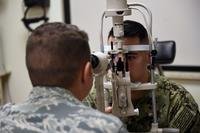The steps are clear for National Guardsmen or reservists who want to turn military service into college credit, according to Michele Spires, assistant vice president of ACE Learning Evaluations at the American Council on Education (ACE).
"It's important that guardsmen and reservists take three steps that I like to call DEL: Determine -- Evaluate -- Learn," Spires said.
According to Spires, who has 30 years of experience in post-traditional and workforce education, DEL means it's essential for guardsmen and reservists to:
- Determine their long and short-term goals;
- Evaluate their military transcript and other academic and professional credentials; and
- Learn transfer of credit protocols at the institution(s), and for the programs, they wish to attend.
"Once the personal and/or professional decision is made to attend a college or university, it's best to start the process right away," Spires said. "It's unfortunate when a student wastes valuable time and money taking classes that are unnecessary duplications of previous courses, because they signed up before their credentials were completely evaluated."
ACE Learning Evaluations has been validating military-connected learning since 1954 through a contract with the Department of Defense that's managed by the Defense Activity for Non-Traditional Education Support (DANTES).
This work aligns academic credit recommendations (in the form of semester-hour credits) for courses and occupations, and then documents them on the joint services transcript (JST) or the ACE working transcript.
Spires said the actual process of aligning military service with college credit can start with a conversation with a college or university adviser to review the service member's digital credentials (the ACE working transcript and/or JST).
"This is part of credit for prior learning [CPL], and it's really important for each individual to think about how the learning they've obtained can support the admissions process, prerequisite requirements or be used as transfer credit to meet course equivalents," she said.
Spires, who is actively engaged in the national discussion on evaluating educational experiences that occur outside the traditional classroom, said there are several factors that affect CPL transfer, such as institutional policy, alignment with appropriate courses, procedures, requirements and transfer application deadlines.
Planning and preparedness are key to success for guardsmen and reservists, Spires said. So how does she recommend they do this?
Research, identify and compare academic institutions that meet their individual needs.
"This could include location, cost, programs, scheduling, accreditation, learning environment, community services and graduation rates," Spires said. "They may also include institutions and academic programs that have policies to maximize their CPL [military credit, etc.]."
Learn and understand those academic institutions' policies and procedures regarding transfer of credit.
"These practices are established by each institution and will vary," Spires said.
Periodically audit and review their credentials, such as military transcripts, for updates and modifications.
"Learning is continuous," she said, "and managing those learning records for accuracy mitigates errors and confusion during the official process."
Initiate the transcript and transfer review process early, even with their application to the institution.
"Have all official transcripts from previous colleges and service branches sent for evaluation as quickly as possible," Spires said. "Official copies must be securely transferred electronically or bear the appropriate institutional signatures, seal and date of issuance."
Engage with the academic adviser.
"He or she should be able to help guardsmen/reservists avoid taking classes for which they may receive transfer credit until an official evaluation is completed," she said.
More than 2,300 colleges and universities accept ACE credit recommendations, according to Spires, which ensures guardsmen and reservists can find the right institution to fit their goals.
"Credit for prior learning will help save time, reduce costs, aid in career planning and lead to more options," Spires said. "Student success is the top priority for colleges and universities, but strong communication at the outset between the institution and the guardsmen/reservist is an important part of building that success."
To that end, Spires recommends guardsmen and reservists consider their degree plan goals and identify potential academic courses for transfer from their learning experiences.
"For example, they can compare credit recommendations to their institution's course catalog or syllabus by reading the learning outcomes and topics documented on the ACE exhibit provided in the ACE National Guide and/or Military Guide," she said.
Also important, according to Spires, is taking ownership during the process and following up with the adviser, registrar or admissions department.
"Most importantly, guardsmen [and] reservists should monitor their curriculum plan, transfer approvals and documentation within formal university systems," she said. "This ensures there's an appropriate alignment of credit and the right classes are being completed, in the proper sequence, for the program plan and pathway."
For more information on college credit transfers, visit the ACE website.
Read the original article on ReserveNationalGuard.com.















